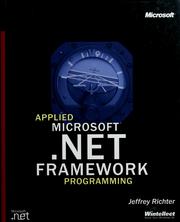| Listing 1 - 10 of 111 | << page >> |
Sort by
|

ISBN: 0130351199 0130493074 Year: 2003 Publisher: Upper Saddle River Pearson Education
Abstract | Keywords | Export | Availability | Bookmark
 Loading...
Loading...Choose an application
- Reference Manager
- EndNote
- RefWorks (Direct export to RefWorks)
Computer organization --- Computer architecture --- hardware --- computers --- CPU --- 681.3*C21 --- 681.3 --- Computerarchitectuur --- Architecture, Computer --- Organization, Computer --- Electronic digital computers --- Network architecture and design: networks (centralized, circuit switching, distributed, packet, store and forward) network communications netword topology --- 681.3*C21 Network architecture and design: networks (centralized, circuit switching, distributed, packet, store and forward) network communications netword topology --- 681.3*C21 Network architecture and design: networks (centralized, circuit switching, distributed, packet, store and forward); network communications; netword topology --- Network architecture and design: networks (centralized, circuit switching, distributed, packet, store and forward); network communications; netword topology --- Computer architecture. Operating systems --- Computer architecture. --- Computer organization.
Book
ISBN: 9789043026970 Year: 2013 Publisher: Amsterdam Pearson Benelux
Abstract | Keywords | Export | Availability | Bookmark
 Loading...
Loading...Choose an application
- Reference Manager
- EndNote
- RefWorks (Direct export to RefWorks)
Telecommunication technology --- Computer architecture. Operating systems --- 681.3*C21 --- Network architecture and design: networks (centralized, circuit switching, distributed, packet, store and forward); network communications; netword topology --- Computernetwerken --- 681.3*C21 Network architecture and design: networks (centralized, circuit switching, distributed, packet, store and forward); network communications; netword topology --- Netwerken --- Informatica
Dissertation
ISBN: 9056827448 Year: 2006 Publisher: Leuven Katholieke Universiteit Leuven
Abstract | Keywords | Export | Availability | Bookmark
 Loading...
Loading...Choose an application
- Reference Manager
- EndNote
- RefWorks (Direct export to RefWorks)
Computers die verbonden zijn met een netwerk maken tegenwoordig integraal deel uit van de hedendaagse samenleving. Ook het onafgebroken verbonden zijn met het Internet is steeds vaker gewenst. Hedendaagse computernetwerken worden gerealiseerd aan de hand van een groot aantal netwerkverbindingstechnologieën, zoals Ethernet, DSL, draadloos Ethernet, UMTS, etc. Daarenboven zijn communicatie-apparaten klein genoeg geworden om makkelijk te kunnen worden meegenomen. Ze worden steeds vaker gebruikt in publieke plaatsen en maken gebruik van publiek beschikbare toegangsnetwerken. Ondanks de beschikbaarheid van al deze verbindingstechnologieën, goed uitgeruste netwerkapparaten en het gebruik van zorgvuldig ontworpen communicatiesoftware, raken computerapplicaties nog steeds in de problemen wanneer ze uitgevoerd worden in dergelijke mobiele, heterogene netwerkomgevingen. De gebruikte netwerkadressen en -protocollen wijzigen, netwerkkarakteristieken (bandbreedte, vertraging,...) veranderen en netwerkloskoppelingen komen frequent voor. Deze problemen geven aanleiding tot vier uitdagingen voor de volgende generaties van mobiliteitsoplossingen. Ten eerste moeten mobiliteitsoplossingen adres- en protocolwijzigingen ondersteunen. Ten tweede moeten applicaties op de hoogte gebracht worden van mobiliteitsgebeurtenissen indien ze dat wensen. Ten derde moet het omschakelen naar een ander verbindingsnetwerk op een veilige manier kunnen gebeuren. Ten vierde moet het mogelijk zijn om mobiliteitsoplossingen toe te passen in heterogene netwerken waar verbindingstechnologieën en communicatieprotocollen snel evolueren. De bijdrage van dit proefschrift is een mobiliteitsoplossingsarchitectuur dat deze uitdagingen adresseert door een sessielaag te introduceren in de protocolstapel. Deze architectuur is gerealiseerd door twee subsystemen: het Verbindingsabstractiesysteem (VAS) en het Adresbeheersysteem (ABS). Het VAS definieert een sessie als een logisch communicatiekanaal tussen twee applicaties. Communicatie wordt gerealiseerd aan de hand van transportprotocollen die op dat moment beschikbaar zijn. Transportprotocolverbindingen die breken tengevolge van mobiliteit worden vervangen door nieuwe verbindingen. Als dat gebeurt verzorgt VAS de betrouwbaarheid van de communicatie en brengt de applicatie op de hoogte als dit gewenst is. Het VAS sessieprotocol kan mobiele applicaties authentiseren als dat nodig is. Protocolwijzigingen worden mogelijk gemaakt door het ABS, die de nodige concepten introduceert om applicaties te kunnen ontwikkelen zonder voorafgaande kennis van de beschikbare protocollen. Beide systemen zijn geïmplementeerd en geëvalueerd in het DiPS+ protocolstapelraamwerk. Computers connected to a network have become an integral part of our society and the idea of being continuously connected to the Internet is gaining more acceptance. Contemporary computer networks are realized using a large number of heterogeneous access technologies, such as Ethernet, DSL, wireless Ethernet, UMTS, etc. Additionally, network devices have become small enough to be carried around and are used to communicate in public places using publicly available access networks. Despite the availability of all these access technologies, well-equipped network devices and the use of carefully designed communication software, applications still run into problems when running in such mobile, heterogeneous network environments: network addresses and protocols change, network characteristics (bandwidth, jitter,.) fluctuate and network disconnections occur frequently. These problems lead to four major challenges for the next generation mobility solutions: First, the mobility solution must support both address and protocol changes. Secondly, when desired, applications must be kept aware of mobility events. Thirdly, switching to another access network must happen in a secure way. Fourthly, it must be possible to deploy the solution in a heterogeneous network where access technologies and communication protocols evolve quickly. This dissertation contributes a mobility solution architecture that addresses these challenges by introducing a session layer protocol in the protocol stack. This architecture is realized by two subsystems: the Connection Abstractions System (CAS) and the Address Management System (AMS). The CAS defines a session as a logical communication channel between two applications. Communication for a CAS session is realized using the transport protocols that are available at that time. Transport protocol connections that are aborted as a consequence of mobility are replaced by new connections. If this happens, the CAS maintains communication reliability and optionally informs the application. The CAS's session protocol can authenticate the moving applications if that is desired. Protocol changes are enabled by the AMS, which introduces the necessary concepts for developing network application development without prior knowledge of the available communication protocols. Both systems are implemented and evaluated using the DiPS+ protocol stack framework.
681.3*C21 <043> --- Academic collection --- Network architecture and design: networks (centralized, circuit switching, distributed, packet, store and forward); network communications; netword topology--Dissertaties --- Theses --- 681.3*C21 <043> Network architecture and design: networks (centralized, circuit switching, distributed, packet, store and forward); network communications; netword topology--Dissertaties
Book
ISBN: 0273028421 Year: 1987 Publisher: London Pitman
Abstract | Keywords | Export | Availability | Bookmark
 Loading...
Loading...Choose an application
- Reference Manager
- EndNote
- RefWorks (Direct export to RefWorks)
SNA (Computer network architecture) --- SNA (Architecture de réseaux) --- 681.3*C21 --- Network architecture and design: networks (centralized, circuit switching, distributed, packet, store and forward); network communications; netword topology --- 681.3*C21 Network architecture and design: networks (centralized, circuit switching, distributed, packet, store and forward); network communications; netword topology --- SNA (Architecture de réseaux)

ISBN: 0735614229 9780735614222 Year: 2002 Publisher: Redmond Microsoft press
Abstract | Keywords | Export | Availability | Bookmark
 Loading...
Loading...Choose an application
- Reference Manager
- EndNote
- RefWorks (Direct export to RefWorks)
Microsoft.net framework. --- Internet programming. --- Programmation sur Internet --- Microsoft .NET Framework --- Internet programming --- 681.3*C21 --- Network architecture and design: networks (centralized, circuit switching, distributed, packet, store and forward); network communications; netword topology --- 681.3*C21 Network architecture and design: networks (centralized, circuit switching, distributed, packet, store and forward); network communications; netword topology --- Computer programming

ISBN: 0321180860 9780321180865 Year: 2005 Publisher: Upper Saddle River Addison-Wesley
Abstract | Keywords | Export | Availability | Bookmark
 Loading...
Loading...Choose an application
- Reference Manager
- EndNote
- RefWorks (Direct export to RefWorks)
Web services --- Computer network architectures --- Web services. --- Computer network architectures. --- 681.3*C21 --- Architectures, Computer network --- Network architectures, Computer --- Computer architecture --- Application software --- Cloud computing --- Network architecture and design: networks (centralized, circuit switching, distributed, packet, store and forward); network communications; netword topology --- 681.3*C21 Network architecture and design: networks (centralized, circuit switching, distributed, packet, store and forward); network communications; netword topology

ISBN: 0470867396 9780470867396 Year: 2004 Publisher: Chichester Wiley
Abstract | Keywords | Export | Availability | Bookmark
 Loading...
Loading...Choose an application
- Reference Manager
- EndNote
- RefWorks (Direct export to RefWorks)
Computer networks --- Design and construction --- Scalability --- 681.3*C21 --- #BAVD --- Network architecture and design: networks (centralized, circuit switching, distributed, packet, store and forward); network communications; netword topology --- 681.3*C21 Network architecture and design: networks (centralized, circuit switching, distributed, packet, store and forward); network communications; netword topology --- Scalability of computer networks --- Computer networks - Design and construction --- Computer networks - Scalability

ISBN: 0201052083 Year: 1984 Publisher: Reading (Mass.): Addison-Wesley
Abstract | Keywords | Export | Availability | Bookmark
 Loading...
Loading...Choose an application
- Reference Manager
- EndNote
- RefWorks (Direct export to RefWorks)
Data transmission systems --- 681.3*C21 --- Data communication systems --- Transmission of data --- Digital communications --- Electronic data processing --- Electronic systems --- Information theory --- Telecommunication systems --- Network architecture and design: networks (centralized, circuit switching, distributed, packet, store and forward); network communications; netword topology --- Data transmission systems. --- 681.3*C21 Network architecture and design: networks (centralized, circuit switching, distributed, packet, store and forward); network communications; netword topology
Multi
ISBN: 9058920208 Year: 2002
Abstract | Keywords | Export | Availability | Bookmark
 Loading...
Loading...Choose an application
- Reference Manager
- EndNote
- RefWorks (Direct export to RefWorks)
658.8 --- 681.3*C21 --- Marketing. Sales. Selling. Distribution --- Network architecture and design: networks (centralized, circuit switching, distributed, packet, store and forward); network communications; netword topology --- 681.3*C21 Network architecture and design: networks (centralized, circuit switching, distributed, packet, store and forward); network communications; netword topology --- 658.8 Marketing. Sales. Selling. Distribution

ISBN: 0070342490 0071144307 9780070342491 9780071144308 Year: 1997 Publisher: New York (N.Y.) : McGraw-Hill,
Abstract | Keywords | Export | Availability | Bookmark
 Loading...
Loading...Choose an application
- Reference Manager
- EndNote
- RefWorks (Direct export to RefWorks)
681.3*C21 --- Network architecture and design: networks (centralized, circuit switching, distributed, packet, store and forward); network communications; netword topology --- 681.3*C21 Network architecture and design: networks (centralized, circuit switching, distributed, packet, store and forward); network communications; netword topology --- Integrated services digital networks
| Listing 1 - 10 of 111 | << page >> |
Sort by
|

 Search
Search Feedback
Feedback About
About Help
Help News
News